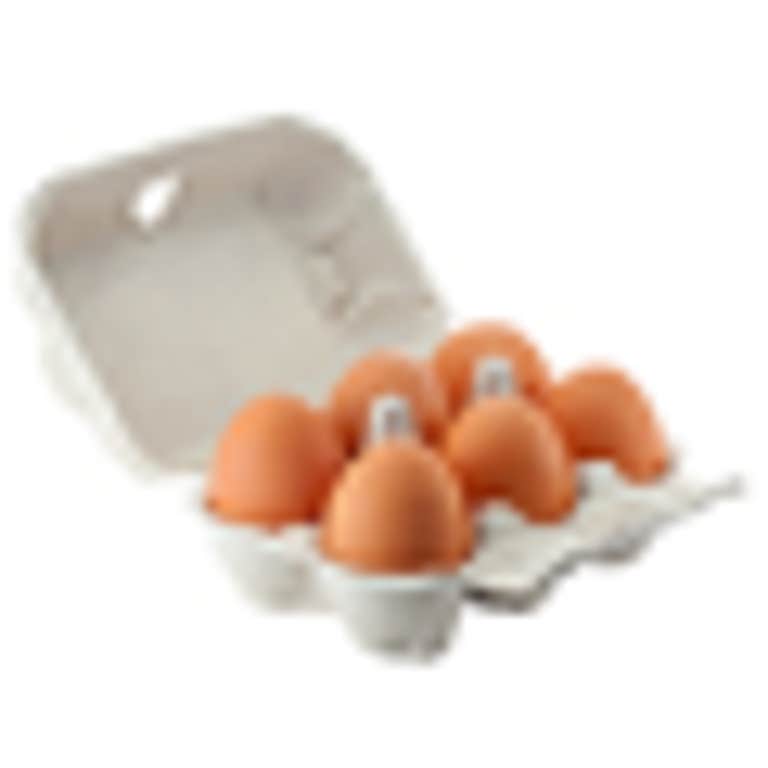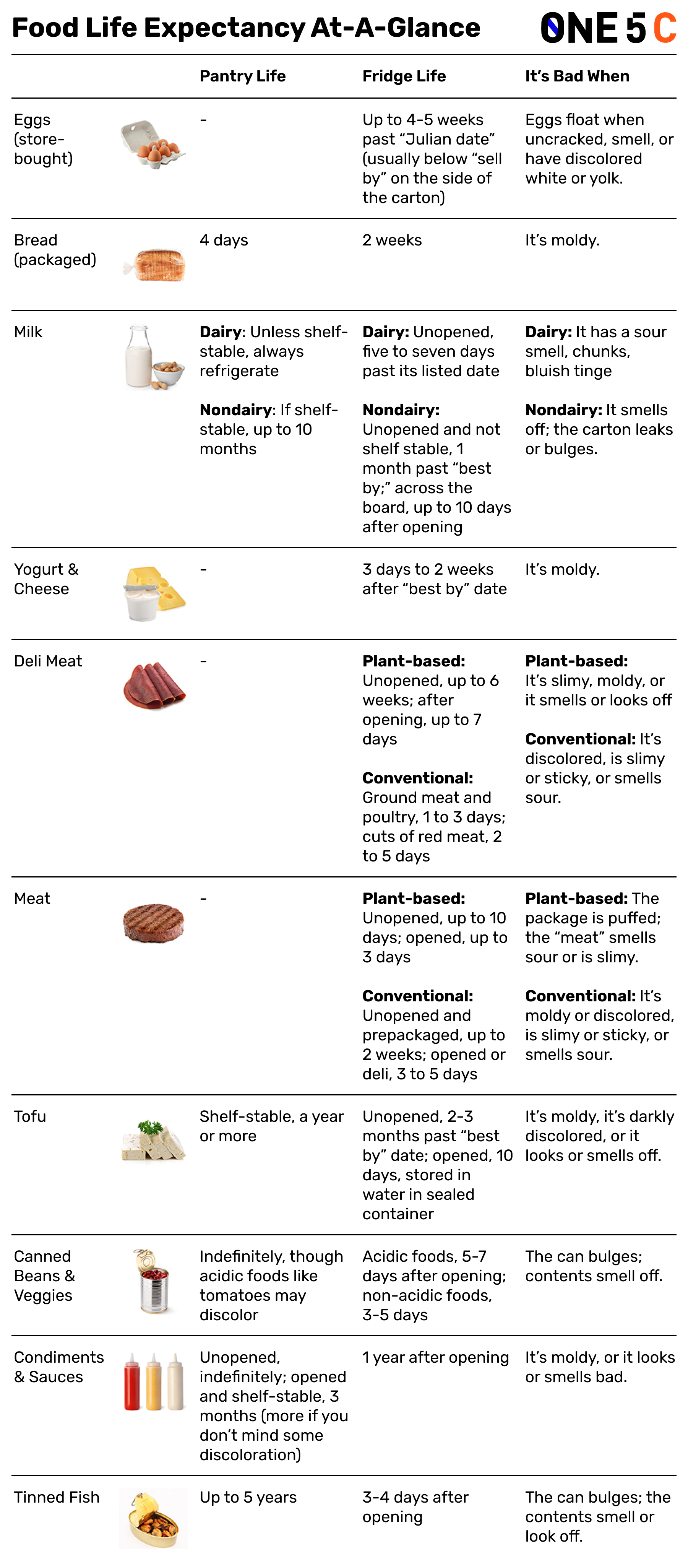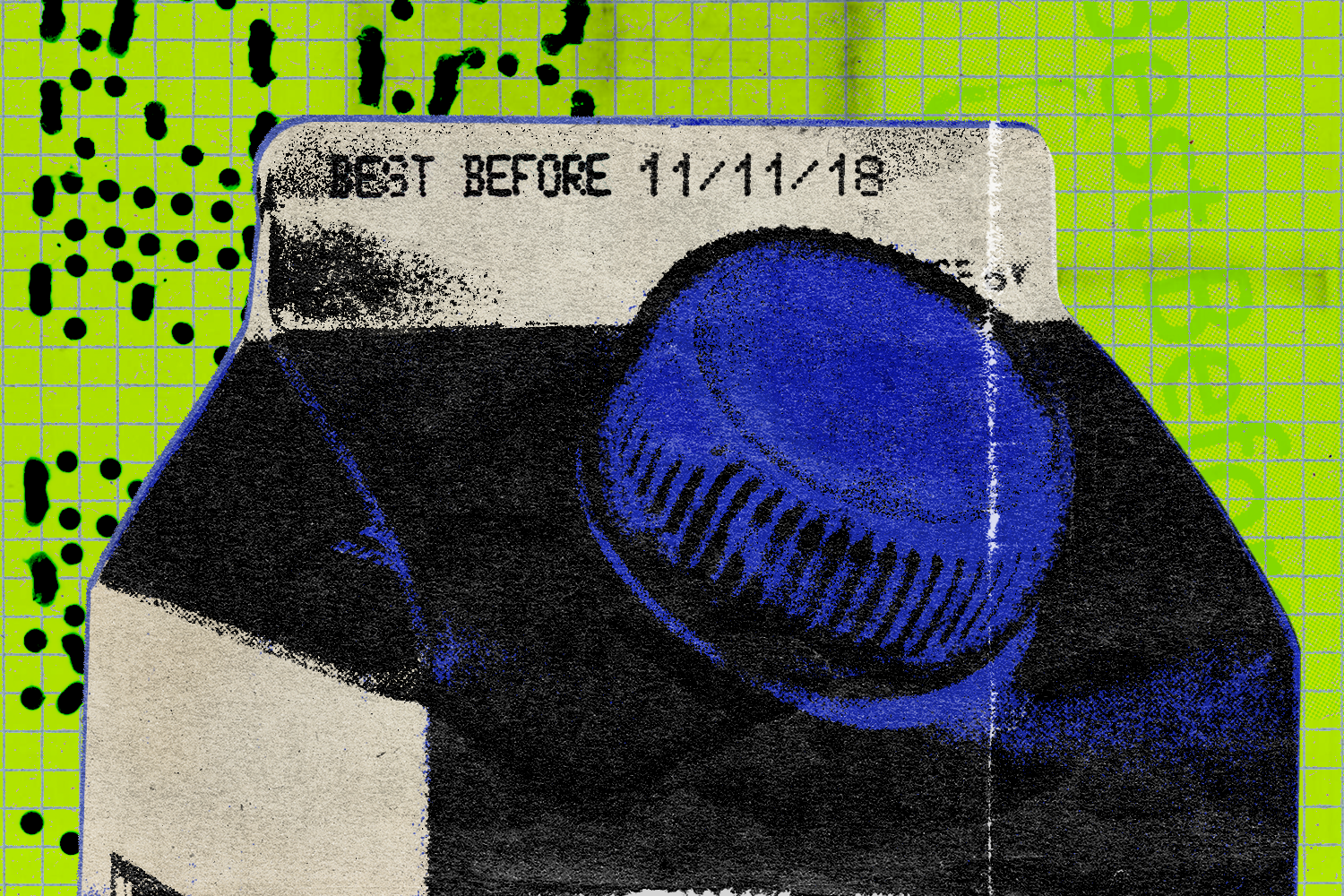This post has been updated. It was originally published on March 14, 2024.
You open the fridge and excavate a container of tofu that’s been hiding behind the beer, only to find that its “best by” date passed last week. It looks okay—nothing blue and fuzzy going on—but the phrase “When in doubt, throw it out” is lodged in your head, right where your parents stuck it, and so you toss it. You’re not alone.
Food waste accounts for more trash than any other type in the U.S., yet manufacturers slap all kinds of dates on packaged grub, tacitly encouraging people to turn potentially good food into even more rubbish. Confusion over what these dates mean is a leading cause of food waste in U.S. homes. According to ReFED, a nonprofit focused on food waste solutions, opaque dates led to 1.45 million tons (about 5.6%) of household chucked grub in 2023; across all sectors (that includes stores and restaurants), that total is 4.24 million tons.1
What do expiration dates mean?
“Expiration” is a big misnomer here. The dates printed on food items aren’t necessarily indicators of a product’s safety as much as when it’s at its highest quality. It’s like this:
- Sell by tells the store when to take something off the shelf
- Best by connotes when a product is of peak flavor and quality
- Use by is when the manufacturer thinks the quality will start to decline, but it’s not a deadline, except with baby formula
How long do foods actually last?
The bottom line is most food will be safe to consume past the date label indication. Check for signs of spoilage, including odor, flavor, or texture. Food stored properly will last longer and is generally important for preventing food poisoning, which is a concern even when consuming food prior to the expiration date.
What that means exactly, though, can vary from food to food. So, in the interest of keeping edible chow out of the landfill, we dug into how long common packaged foods can remain safe to consume. The internet will feed you enough advice on this front to make your head spin, but we got dizzy so you don’t have to and compiled the best guidance for the longevity of pantry and fridge staples.
And remember, none of this is an exact science. Think of these as guidelines, and use your best judgment before feeding yourself or your friends and family.
Food life expectancy, at a glance
| Pantry Life | Fridge Life | It’s Bad When | |
|---|---|---|---|
Eggs (store-bought) | – | Up to 4-5 weeks past “Julian date” (usually below “sell by” on the side of the carton) | Eggs float when uncracked, smell, or have discolored white or yolk |
Bread (packaged) | 4 days | 2 weeks | It’s moldy |
Milk | Dairy: Always refrigerate Non-dairy: Shelf-stable, up to 10 months | Dairy: When unopened, five to seven days past its listed date Nondairy: Unopened and not shelf stable, 1 month past “best by;” across the board, up to 10 days after opening | Dairy: Sour smell, chunks, bluish tinge Nondairy: It smells off; the carton leaks or bulges |
Yogurt & Cheese (dairy and non-dairy) | – | 3 days to 2 weeks after “best by” date or one week if opened | It’s moldy, chunky, or smelly |
Deli Meat | – | Plant-based: Unopened, up to 6 weeks; after opening, up to 7 days Conventional: Ground meat and poultry, 1 to 3 days; cuts of red meat, 2 to 5 days | Plant-based: It’s slimy, moldy, or it smells or looks off. Conventional: It’s discolored, is slimy or sticky, or smells sour. |
Meat | – | Plant-based: Unopened, up to 10 days; opened, up to 3 days Conventional: Unopened and prepackaged, up to 2 weeks; opened or deli, 3 to 5 days | Plant-based: The package is puffed; the “meat” smells sour or is slimy Conventional: It’s moldy or discolored, is slimy or sticky, or smells sour |
Tofu | Shelf-stable, a year or more | Unopened, 2-3 months past “best by” date; opened, 10 days, stored in water in sealed container | It’s moldy, it’s darkly discolored, or it looks or smells off |
Canned Beans & Veggies | Indefinitely, though acidic foods like tomatoes may discolor | Acidic foods, 5-7 days after opening; non-acidic foods 3-5 days | The can bulges; contents smell off |
Condiments & Sauces | Unopened indefinitely; opened and shelf-stable, 3 months (more if you don’t mind some discoloration) | 1 year after opening | It’s moldy, or it looks or smells bad |
Tinned Fish | Up to 5 years | 3-4 days after opening | The can bulges; the contents smell or look off |

In depth: Common food expiration questions
How long after expiration date are eggs good?
Egg cartons with the USDA grade logo typically feature a “Use by,” “Use before,” or “Best before” date, which estimates the maximum amount of time the eggs will maintain optimal quality when stored under ideal conditions. Legally, these dates can’t exceed 45 days after the eggs were packed, which is why the marks on cartons also include the packing date.
The good news? Properly-refrigerated eggs can keep up to five weeks beyond that. To double check, look for the Julian date––the three-digit number on your carton––which will tell you the exact day of the year your eggs were packed. Above all else, trust your gut (or maybe your senses, first): If an egg doesn’t float in water, has no funky odors, or doesn’t have a weirdly-colored white or yolk, consider yourself in the safe zone.
How long is yogurt good after its expiration date?
The short answer: Yogurt is usually good until it’s noticeably goes bad. Telltale signs of spoilage include a rancid or sour smell, curdling, way more liquid than usual, or straight-up mold. While federal law doesn’t require expiration dates on products like yogurt, many manufacturers offer “Best If Used By/Before” or “Use-By” dates to indicate when something’s quality will likely start to decline.
Some dietitians estimate that yogurt is usually good for up to two weeks after its listed date, but others point out yogurt containing fruit (which can harbor yeast and mold) may spoil faster. Once opened, yogurt typically lasts a week past the date stamped on it max, especially when exposed to air or bacteria––like when a licked spoon goes right back in the tub.
How long is milk good after its expiration date?
While there aren’t any recommendations set in stone, most research suggests unopened milk is usually good for five to seven days past its listed date. Opened milk, on the other hand, lasts at least two to three days. Some general rules of thumb? Don’t drink milk if it’s got an acidic, sour smell to it. Pasteurized milk is white in color, so if it’s got a bluish tinge, there could be mold growing in your drink. And, if it’s chunky? That’s curdling, and your milk is officially a no-go.
How long does frozen food last?
Frozen foods stored continuously at 0 degrees F (-18 degrees C) or below can theoretically stay edible indefinitely. But just because something stays safe to eat doesn’t mean it’ll still taste great. Freezing affects food quality, and how long something stays delicious depends on what it is. A whole turkey, for example, can keep in the freezer for up to a year and still taste fresh, but bacon? Give it more than a month, and you’re in for some serious disappointment. The reason?
Freezer burn––when little ice crystals form on your frozen foods––dries out the water content in your meals, which can degrade their color, texture, and flavor. Though it doesn’t necessarily render grub inedible.
How long do leftovers last?
Spores can germinate in food left out at room temperatures, creating heat-stable baddies that even reheating can’t kill––so be sure to store your leftovers properly to avoid getting a serious case of food poisoning. The USDA says leftovers can hang out in the fridge for up to four days or frozen for three to four months.
Technically, frozen leftovers are safe to eat until the end of time. Still, after too much time in the ice chamber, they’ll start to wither up and lose their flavor. That’s because all foods contain water and form thousands of ice crystals when frozen. Over time, these crystals move all the way up to the surface of your food and migrate to the coldest part of your freezer––making your three-month-old meal-prep shriveled, dry, and tough.
Additional reporting by Audrey Chan.

